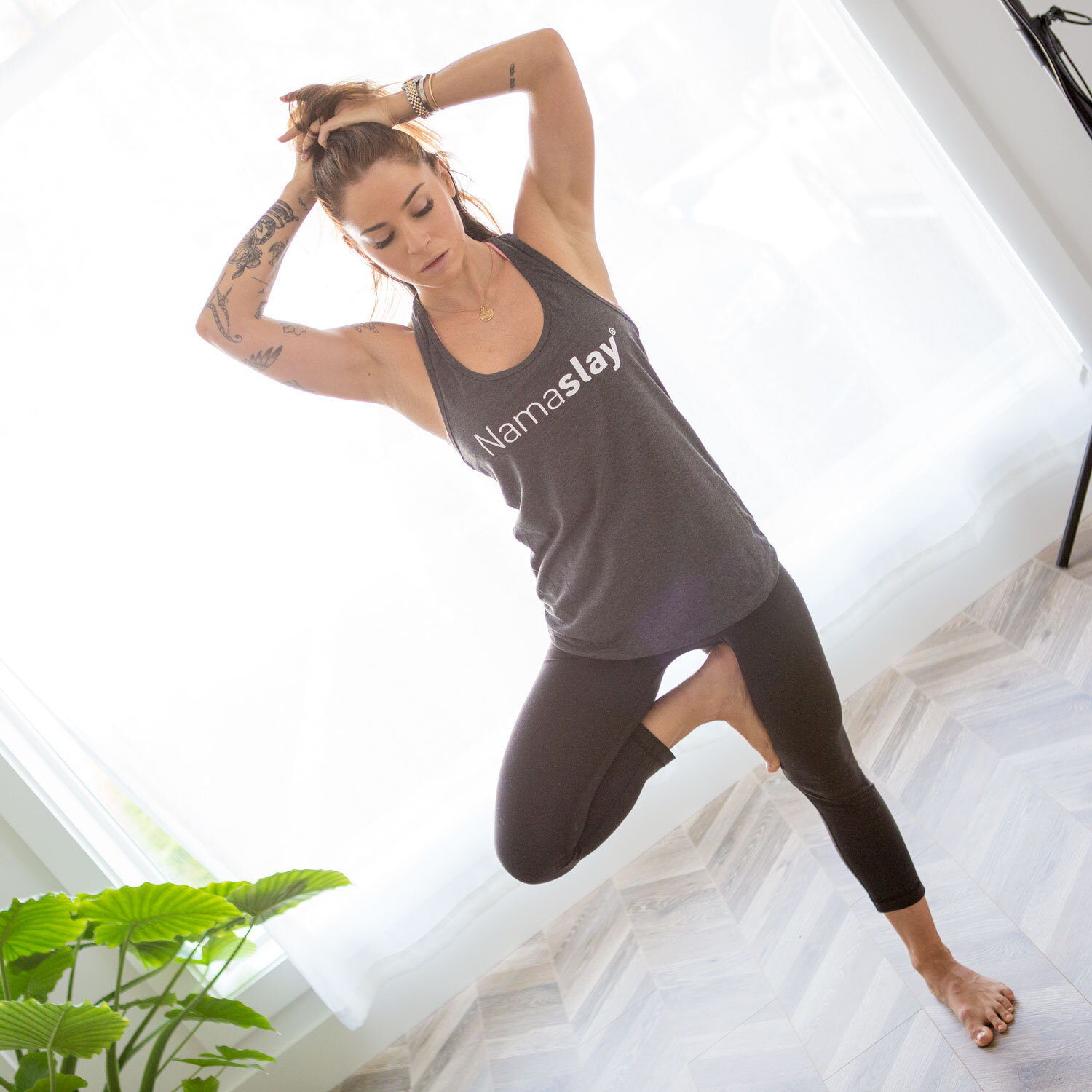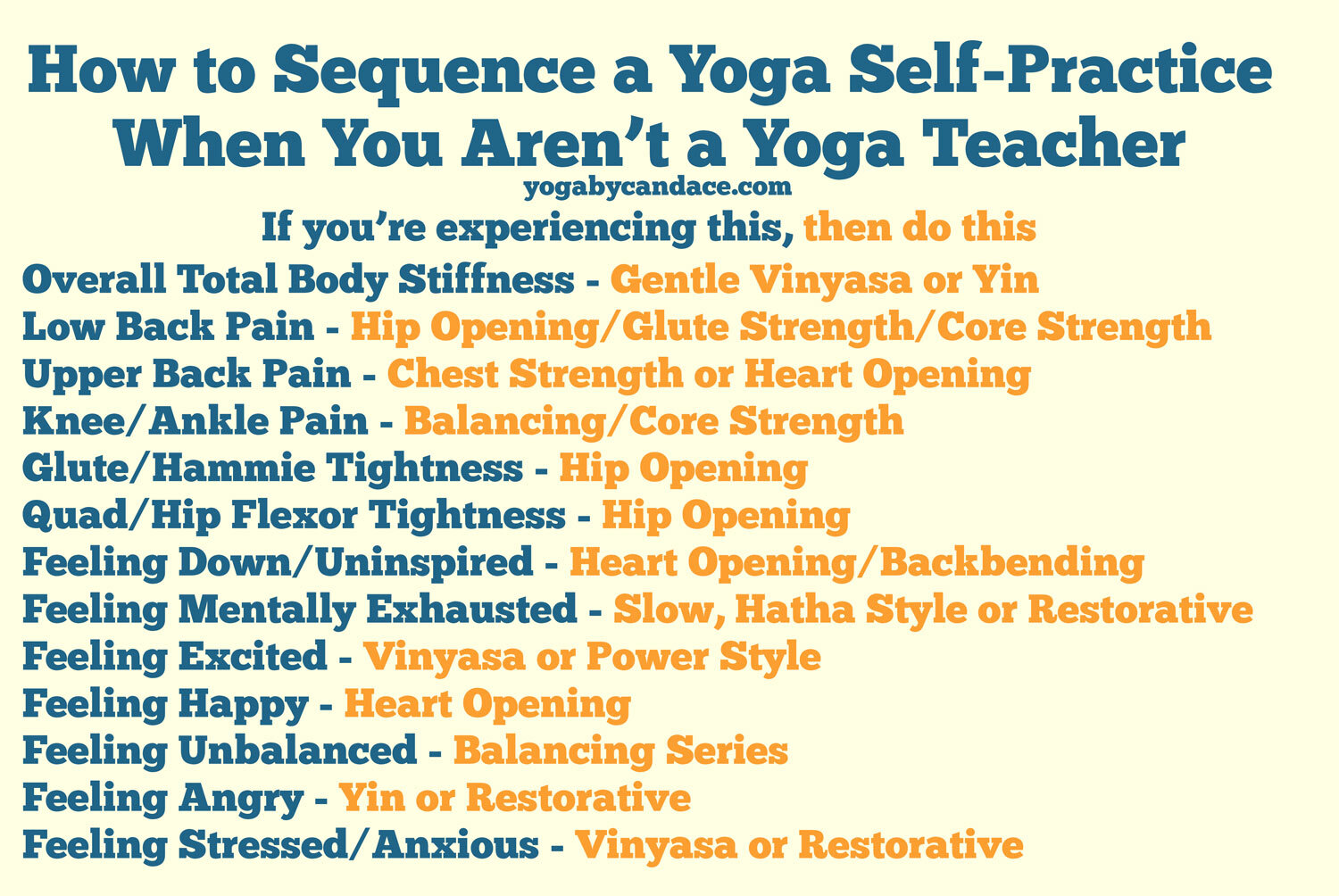Disclaimer: This post contains affiliate links which means YBC® will earn a small commission if you happen to make a purchase. Thanks for the support.
One of the most frequent questions I get is about my self-practice. I will often just move the way my body wants to move, and if I’m filming it (because, #content), then I’ll share it and people will ask how I remember it all. The secret? I don’t.
I truly just let my body move how it wants to move. If I happen to skip a pose, it’s not the end of the world for me. If I’m sequencing for a yoga class I’m teaching, that’s much different, and I’m always trying my best to ensure both sides are even and there aren’t any funky things going on, but sometimes I think it’s nice to simply let your body move how it wants to move. That, however, takes a while to learn how to do.
The trouble is that unless you’re a yoga teacher with lots of experience, or a super free spirit, or have a background in dance, the likelihood of you allowing yourself the freedom to move is slim. Many of us have been conditioned to “be normal” - ha! - and so intuitive movement isn’t something many of us are used to. If that sounds like you, here are some tips to start being able to sequence your own yoga self-practice.
Start with Self-Enquiry
Ask yourself what you need today. That might be something physical, say, you notice that your low back hurts. Ok, so you likely need a specific physical sequence that will help with that. Or it might be something emotional, like you’re feeling closed off and sort of down, which may signify a heart-opening yoga sequence will be most beneficial. Figure out what you need and see if one of the below helps you.
Follow us on Pinterest and Pin this now, then use it later!
I want to qualify all this by noting that the above is not something set in stone. For example, sometimes we feel excited, but it’s too much, and we’d rather feel more grounded. If that’s the case, I probably wouldn’t do a vinyasa or power style as recommended. So take the above as a very loose, very general guideline. If you’re a total beginner, and have no idea where to start. Let’s break it down:
Body Feels Stiff
If your body feels super stiff, I would practice gentle vinyasa or yin. Gentle Vinyasa would refer to things like sun salutations, moving slow and mindfully. Yin yoga is a style that requires props like cork yoga blocks, bolsters, and straps. You could great creative and use whatever you have around the house (i.e. a belt doubles as a great yoga strap!). Move slowly and mindfully.
Low Back Pain
Obviously if you’re in serious pain, you’ve got to get yourself to a medical professional. But if it’s minor, yoga may be helpful. Low back pain can be due to a number of things - tight hips, weak glutes, weak core, etc. You know your body best - of those three, which might pertain to you? (And please understand you might have all three!) If you’re dealing with tightness through the hips, then hip opening will be helpful. Got weak glutes? Doing some glute bridges, or pulsing up and down while in high lunge may be helpful, or simply focusing on pressing into your heels rather than the balls of the feet while you’re practicing may bring just the awareness you need to fire the glutes. Got a weak core? Incorporate movements like regular plank, side planks, or get funky with it.
Upper Back Pain
Again, if it’s serious pain, you need to see a medical professional, but if it’s minor, yoga might help. For upper back issues, you may want to think about strengthening the upper back with poses like locust, supermans, and warrior 3, which are all broken down beautifully in Namaslay. Or, if it’s more tightness through the front that you’re experiencing, which is causing the upper back muscle to lock long, you may want to think about front body opening with poses like humble warrior.
Knee or Ankle Pain
Minor knee and ankle pain may be due to weight distribution on your feet in your activities of daily living (ADLs), so you may want to think about balancing poses like Dancer’s Pose or Tree Pose, and core strengthening work like planks and side planks. A strong core can lead to better weight distribution which may lead to less ankle or knee pain.
Glute or Hamstring Tightness
A hip opening yoga practice will be really helpful. You’ll want to think about poses like forward folds and cobbler’s pose to begin to open up that restriction.
Quad or Hip Flexor Tightness
A hip opening yoga practice may also be helpful here as well. Think about front body opening poses like dancer’s pose, crescent lunge, and the like.
Feeling Down or Uninspired
When you’re feeling kind of low, doing a heart opening practice may be really mood enhancing. You’ll want to think about back bending here - starting gentle and then working your way slowly up. Goddess pose arms with your warrior one can feel really opening and uplifting; bridge pose, and wheel are all great ones.
Feeling Mentally Exhausted
When you’re run down mentally (or physically!), a slow, hatha style or restorative approach to self-care may help you to feel nurtured. Grab a bolster, and some props like cork blocks so that your physical practice can be done with ease.
Feeling Excited
If you’re feeling excited (and you want to continue to feel that way), a vinyasa or power yoga practice with sun salutations will keep you that way. Think about flowing, moving with your breath, and if you’ve got a little more energy to burn off, you can make it more power focused by holding the poses for a bit longer before flowing through.
Feeling Happy
Heart opening, back bending practices can keep you feeling light and uplifted. Choose a pose like wheel or camel pose as your peak pose and slowly work your way up.
Feeling Unbalanced
If you’re feeling unbalanced, whether it’s a physical sensation or in your life off the yoga mat, try a balancing sequence like tree pose, eagle, and dancer’s. Feel free to use props like a chair or a wall to help you as you get started.
Feeling Angry
When you’re feeling angry, yin or restorative yoga can be calming and soothing. Grab a bolster and some blocks and hit the mat.
Feeling Stressed or Anxious
When you’re feeling stressed or anxious, vinyasa can be helpful because it helps to burn off excess energy. If you feel stressed or anxious but you’re also feeling depleted of energy, restorative yoga is another way to handle it. Restorative is very slow, nearly effortless and you totally relax, so it’s particularly good for people feeling zapped of energy in addition to feeling either stressed or anxious, or both.
How to Warm Up Intelligently
Once you figure out what kind of practice you need, start thinking about your warm up. You’ll want to warm up intelligently so that you avoid injury. I suggest starting slow, no matter what type of practice you’ll do. The spine moves six ways:
Laterally to the side - think, seated and leaning over to one side
Laterally to the other side - see above
Flexion - Think, a gentle forward fold as seen in cat/cow pose
Extension - Think, a gentle backbend as seen in cat/cow pose
Rotating to the right - A gentle twist
Rotating to the left - A gentle twist to the other side
Keep moving in those ways until you feel warmed up
Wrists and Ankles
Depending on what kind of practice you’ll be doing, you may want to consider warming up the wrists and ankles with simple circles, or gentle pressure like turning your hands in all sorts of directions while on all fours or a wrist warm up. Basically, don’t pop up into crow pose if you haven’t warmed up your wrists!
Gentle Flows First Before More Powerful Flows
As a basic rule of thumb, if you’re going to be doing a powerful vinyasa practice, don’t just come right into it after your warm up, gradually increase the intensity from very slow warm up to slow vinyasa to full-on vinyasa. That is, breathe a few breaths in your first downward dog, and give yourself permission to bend your knees a few times, shake out the hips and the head, and just let it be sort of forgivably sloppy, as you’re still in the warm-up phase. Then, with each downward dog after that, you can tighten up your alignment attention and be a bit more powerful with it.
Consider Working Up to a Peak Pose
Not every yoga practice has to have a peak pose, or a pose that you work your way up to, but if you’re going to have one, decide what it will be at the beginning and then have a general idea of how you will safely get yourself there. For example, if you’re wanting to do a back-bending practice, and work your way up to wheel pose, you’re not going to start with bridge and then go right into wheel! You’ve got to safely warm your entire body up for it, and activate certain parts of the body so that it’s ready to get into wheel. Think about the shape the arms and legs make in your peak pose and see where you can implement less intense versions of that throughout your practice as you work your way up. For example, in wheel pose, we know the arms will extend overhead. Therefore, in your vinyasas, you may want to think about coming into a crescent pose, and perhaps bending at one elbow, capping the elbow with the opposite hand, and breathing a few deep breaths there to send the body a message that says, ‘Hey, eventually we’re going to get into wheel - let’s prep the arms and upper back for this position!’
Listen to Your Body
Throughout the entire practice, but particularly when it’s time to come into your peak pose, if you have one, listen to your body. That’s the number one rule here. Remember that yoga teachers have to have a minimum of 200 hours of study before they should feel ready to lead a full yoga class that is beautifully sequenced. So if you haven’t had that, and you’re feeling like it’s about time to come into your wheel pose but your body is giving you signs it’s not ready, do not force it. Always honor how it feels so you can avoid injury.
And if you love yoga, and truly want to dive into the intricacies of intelligent sequencing, please consider joining our Namaslay® 200hr Yoga Teacher Training Intensive this April 2020 in Santorini, Greece. Or if you have a 200hr under your belt but still feel unsure of what to do, consider joining our Yoga Teacher Training Refresher course this winter in Connecticut.


